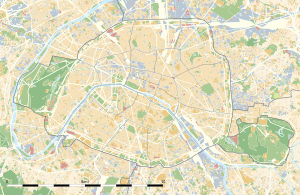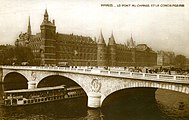Pont au Change
Coordinates: 48 ° 51 '24 " N , 2 ° 20' 48" E
| Pont au Change | ||
|---|---|---|
| use | Road bridge | |
| Crossing of | His | |
| place | Paris | |
| construction | Stone arch bridge | |
| overall length | 103 m | |
| width | 30 m | |
| Number of openings | three | |
| Longest span | 31 m | |
| start of building | 1858 | |
| completion | 1860 | |
| location | ||
|
|
||
The Pont au Change (in German " Geldwechsellerbrücke ") is a road bridge over the Seine in downtown Paris . It connects the Île de la Cité at the level of the Conciergerie with the right bank of the river at the level of the Théâtre du Châtelet . It stands on the border between the first and fourth arrondissements . The bridge got its name from the exchange offices and banks that were located in the bridge houses until 1788 .
description
The 103 m long and 30 m wide stone arch bridge has three arches with spans of 31 m each. Its 18 m wide carriageway is flanked by two 6 m wide sidewalks. It was carried out between 1858 and 1860 according to the plans of the engineers Paul-Martin Gallocher de Lagalisserie and Paul Vaudry . On the front sides it bears the monogram of Napoleon III. While the outer arches used to adjoin the high bank walls, the Voie Georges-Pompidou expressway was added under the right arch from the 1960s .
history
The first wooden bridge built at this point probably dates from the end of the 9th century, shortly after the end of the Norman raids , see also the Siege of Paris (885–886) . It was the extension of the rue Saint-Denis, coming from Flanders and therefore becoming economically more important than the old Roman bridge that took up the rue Saint-Martin coming from Soissons . The bridge led directly from the Rive Droite to the royal palace on the Île de la Cité and was therefore initially called Pont du Roi ("King's Bridge"). To protect them, a fortification, a fort, the Grand Châtelet, in contrast to the Petit Châtelet on the Petit Pont , was built on the land side , which after the construction of the city wall by Philip August , which lost its protective function, became the seat of Prévôt , des royal bailiff of Paris, including courthouse and prison. The place where the bridge meets the north bank is still called Place du Châtelet and is one of the city's most important transport hubs.
As usual in the Middle Ages, the bridge was built on. 140 houses and 112 shops, plus mills, made the bridge over the traffic junction one of the city's economic centers. In 1411 Louis VII ordered the goldsmiths and money changers to settle on this bridge. The bridge still had seven pillars. In the following centuries the building changed its name again and again. Since the royal entourage, after the court moved to the Louvre, crossed this bridge to attend church services in Notre-Dame , the bridge was decorated with some sculptures of French kings, including that of the young Louis XIV , which are now in the Louvre .
Historical paintings
- Hubert Robert : Demolition of the houses on the Pont au Change (1788). The picture shows the vaults at bridge level, above which the higher floors have already been demolished. Building materials are transported away with ox wagons. The location of the painting is the Musée Carnavalet in Paris, a second version is in the Neue Pinakothek in Munich.
Literary mention
In the novel Perfume by Patrick Suskind is on the Pont au Change to the collapse of a bridge segment the house and the workshop of the perfumer Giuseppe Baldini.
The bridge is also the setting in Victor Hugo's story Le dernier jour d'un condamné and the novel Les Misérables . In the latter, Inspector Javert throws himself off the bridge because he has lost faith in justice.
After 1900, the Palais de Justice in the background
Web links
literature
- Félix Lazare, Louis Lazare: Dictionnaire historique des rues et monuments de Paris en 1855 avec les plans des 48 quartiers. Maisonneuve & Larose, Paris 2003, ISBN 2-86877-184-X .



